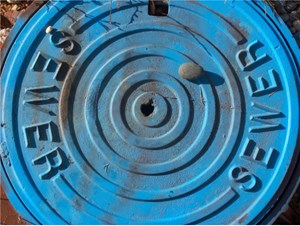Water infrastructure across the country vulnerable to climate change, AP reports
LUDLOW, Vermont (AP) — The crack of a summer thunderstorm once comforted people in Ludlow, Vermont. But that was before a storm dropped eight inches of rain on the village of 2,200 in two days last month. And it was before the devastation of Tropical Storm Irene in 2011. Now a coming rainstorm can stir panic.

“We could lose everything again,” said Brendan McNamara, Ludlow’s municipal manager.
The rainfall that walloped Vermont last month hit Ludlow so hard that floodwaters carried away cars and wiped out roads. It sent mud and debris into homes and businesses and forced officials to close a main road for days.
Thankfully, the facility that keeps the village’s drinking water safe was built at elevation and survived. But its sewage plant fared less well. Flooding tore through it, uprooting chunks of road, damaging buildings and sweeping sewage from treatment tanks into the river. Even now the plant can only handle half its normal load.
It’s not just Ludlow. Water infrastructure across the country is vulnerable as climate change makes storms more unpredictable and destructive, flooding coastal sewage systems.
“Wastewater systems are not designed for this changing climate,” said Sri Vedachalam, Director for Water Equity and Climate Resilience at Corvius Infrastructure Solutions LLC. “They were designed for an older climate that probably doesn’t exist anymore.”
A big reason is geography. Wastewater systems — which deal with sewage or stormwater runoff — are often near water bodies because that is where they discharge. But this makes them vulnerable.
Wastewater systems typically are at the lowest point in the community,” Vedachalam said, noting they often flow by gravity. “In many cases, if you have a really large storm, those are the ones that do get flooded first.”
When storms drop inches of rain onto lakes and rivers over a short period of time, water and debris can clog wastewater systems, power can be knocked out, and service disrupted.
The fact that the nation’s water pipes are aging adds to the risk. The engineering society estimates that a water main breaks in the U.S. every two minutes, leading to six billion gallons of lost water each day, or enough to fill 9,000 swimming pools.
Recent federal spending packages commit billions of dollars to upgrading the nation’s water systems, but the roughly $55 billion for upgrades in the Biden administration’s $1 trillion infrastructure law represent a fraction of what’s needed to address climate-related risks to water and sewage systems. Part of the reason is that other problems — such as lead pipes — need urgent attention. Often, they have little to do with a changing climate, said Olsen.
And while larger cities such as Boston and Chicago can fund new projects in part by raising rates on customers, smaller cities and towns have to find other funding sources — often through state or federal grants — to avoid driving up bills, according to Adam Carpenter, manager of energy and environmental policy at the American Water Works Association.
Related News
From Archive

- Glenfarne Alaska LNG targets late-2026 construction start for 807-mile pipeline project
- U.S. water reuse boom to fuel $47 billion in infrastructure spending through 2035
- $2.3 billion approved to construct 236-mile Texas-to-Gulf gas pipeline
- Major water pipe break in Puerto Rico hits over 165,000 customers
- Potomac River Tunnel project enters construction phase beneath Washington, D.C.
- Pennsylvania American Water launches interactive map to identify, replace lead water service lines
- Trump's tariffs drive $33 million cost increase for Cincinnati sewer project
- Utah city launches historic $70 million tunnel project using box jacking under active rail line
- Tulsa residents warned after sewer lines damaged by boring work
- Fatal trench collapse halts sewer construction in Massachusetts; two workers hospitalized



Comments